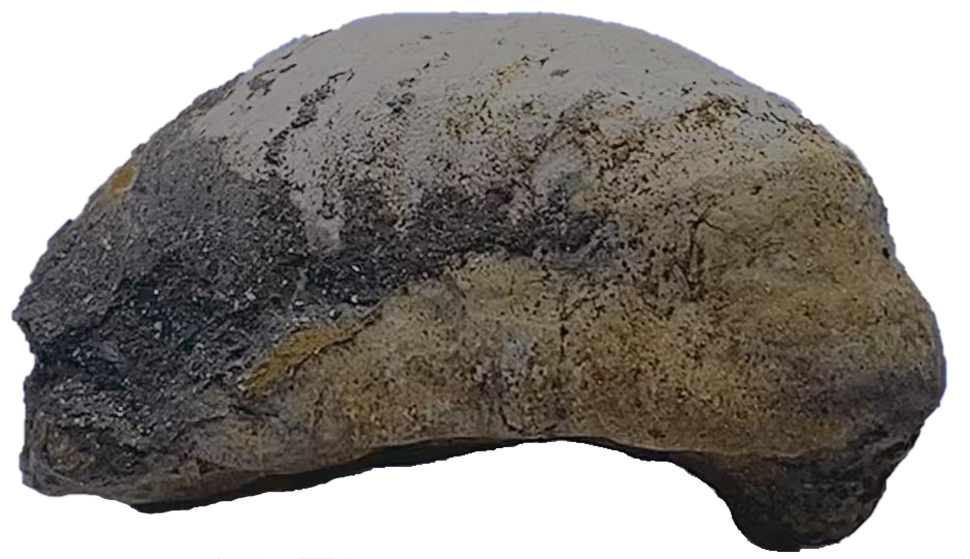
The fossil known as the Devils Toenail is actually Gryphaea, an extinct genus of oyster that lived during the Jurassic and Cretaceous periods. Its name derives from its distinctive, curved, claw-like shape, which resembles a grotesque toenail. In folklore, these fossils were believed to be remnants of the Devil’s own talons, shed as he walked the Earth. This superstition persisted for centuries, with some even believing they held protective or healing properties.
Composition and Formation
Gryphaea fossils are composed primarily of calcium carbonate, the same material found in modern oyster shells. Over millions of years, these marine bivalves were buried in sediment and fossilised, preserving their ridged, asymmetric structure. Their unique shape developed as an adaptation for anchoring themselves in the seabed while filtering food from the water.
Locations and Distribution
Fossils of Gryphaea are commonly found in Europe and North America, particularly in Britain, France, and parts of the United States. In the UK, they are frequently unearthed in the Jurassic limestone formations of the Midlands, Yorkshire, and the Dorset coast. Due to their widespread distribution, these fossils provide valuable insights into prehistoric marine environments.
Physical Characteristics
- Shape: Asymmetrical and curved, resembling a thick, ridged claw.
- Size: Varies, with some reaching up to 10 cm in length.
- Texture: Heavily ridged, with growth lines visible along the shell.
- Colour: Typically grey or brown due to mineralisation over time.
- Structure: One valve (shell) is strongly convex, while the other is flatter, allowing it to settle into the seabed.
Archaeological Finds and Historical Usage
Fossilised Gryphaea shells have been collected for centuries, with records dating back to Roman times. In medieval England, these fossils were often carried as charms against rheumatism or arthritis, as people believed their shape signified a natural cure. Some cultures ground them into powder, using them in traditional medicine for ailments related to bones and joints.
Interesting Facts
Mary Anning ( https://siansemporium.com/mary-anning/ )discovered many Gryphaea when she was foraging for fossils on the beaches around Lyme Regis. Devil’s toenails are particularly common in the Lower Jurassic rocks around Scunthorpe. Iron ore was quarried locally and across the midlands (Northamptonshire to Warwickshire) and it is quite common to find Gryphaea in the quarries. In 1936 Scunthorpe’s coat of arms included two Gryphaea.

- Gryphaea is closely related to modern oysters, though its extreme curvature sets it apart.
- These fossils are often found in clusters, indicating that Gryphaea lived in dense marine beds.
- Some fossils have been discovered with boreholes, suggesting predation by prehistoric marine snails.
- Their presence in limestone deposits has helped geologists date rock layers and reconstruct ancient sea levels.
Folklore, Legends and Tales
The name Devil’s Toenail stems from the belief that these fossils were part of the Devil’s body. According to legend, when the Devil was cast from Heaven, his claws dug into the Earth, leaving behind these fossilised remnants. In some regions, they were thought to bring luck and were carried by sailors as protective talismans against storms and shipwrecks. Others saw them as a curse, warning of misfortune to those who possessed them.
Links with Astrology and the Chakra System
Astrologically, Gryphaea fossils are often associated with Capricorn due to their connection with endurance, history, and the Earth’s hidden wisdom. Capricorn, ruled by Saturn, represents patience, structure, and deep-rooted knowledge—traits mirrored in these ancient relics.
In the chakra system, Gryphaea aligns closely with the root chakra (Muladhara), symbolising stability, grounding, and connection to the Earth. Their fossilised nature also ties them to the third eye chakra (Ajna), representing wisdom, past-life insights, and ancient knowledge.
